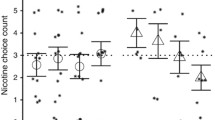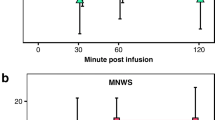Abstract
Nicotine and alcohol are often consumed concurrently by smokers. Each drug alone produces significant subjective and cardiovascular responses, but the effects of the two drugs in combination have rarely been examined. Smokers who were moderate alcohol drinkers (n = 18, 9 males and 9 females) participated in four sessions, involving acute administration of nicotine/placebo and alcohol/no alcohol. Subjects abstained overnight from tobacco and alcohol prior to each session. Nicotine (20 µg/kg per presentation) or placebo was administered by measured-dose nasal spray every 30 min for 2 h following consumption of diet tonic water with or without alcohol (0.5 g/kg). Subjective (visual analog scales, Profile of Mood States, Addiction Research Center Inventory) and cardiovascular (heart rate, systolic and diastolic blood pressure) responses were assessed after each nicotine/placebo administration. Nicotine increased head rush, dizzy, and most stimulant effects (i.e. jittery, tension, and arousal and decreased fatigue and relaxed), while alcohol increased intoxication, head rush, dizzy, and jittery, with no other stimulant effects. Nicotine and alcohol generally produced additive subjective and cardiovascular effects when consumed together, although nicotine attenuated sedating and intoxicating effects of alcohol alone. Furthermore, there were several interaction effects on subjective measures involving gender. Nicotine plus alcohol tended to attenuate some subjective effects due to one drug or the other alone in men but enhanced the effects of either alone in women. These findings indicate that nicotine and alcohol generally have additive subjective and cardiovascular effects, but that men and women differentially respond on some subjective measures to the combination of alcohol and nicotine.
Similar content being viewed by others
References
Adler MW (1986) Critical factors in studying drug interactions. In Braude MC, Ginzburg HM (eds) Strategies for research on the interactions of drugs of abuse. NIDA Research Monograph 68, US Govt Printing Office, Washington DC, pp. 6–13
Benowitz NL, Jones RT, Jacob PJ (1986) Additive cardiovascular effects of nicotine and ethanol. Clin Pharmacol Ther 40:420–424
Chait LD, Perry JL (1994) Acute and residual effects of alcohol and marijuana, alone and in combination, on mood and performance. Psychopharmacology 115:340–349
Cummings KM, Jaen CR, Giovino G (1985) Circumstances surrounding relapse in a group of recent exsmokers. Prev Med 14:195–202
deWit H, McCracken SG (1990) Ethanol self-administration in males and females with and without an alcoholic first-degree relative. Alcohol Clin Exp Res 14:63–70
deWit H, Metz J, Wagner N, Cooper M (1990) Behavioral and subjective effects of ethanol: relationship to cerebral metabolism using PET. Alcohol: Clin Exp Res 14:482–489
Dews PB, Wenger GR (1977) Rate-dependency of the behavioral effects of amphetamine. In: Thompson T, Dews PB (eds) Advances in behavioral pharmacology, vol. 1. Academic Press, New York, pp 167–227
Dudek BC, Phillips TJ, Hahn ME (1991) Genetic analyses of the biphasic nature of the alcohol dose-response curve. Alcohol Clin Exp Res 15:262–269
Fagerstrom K-O, Schneider NG (1989) Measuring nicotine dependence: a review of the Fagerstrom Tolerance Questionnaire. J Behav Med 12:159–182
Fischman MW, Foltin RW (1991) Utility of subjective-effects measurements in assessing abuse liability of drugs in humans. Br J Addict 86:1563–1570
Gilbert DG (1979) Paradoxical tranquilizing and emotion-reducing effects of nicotine. Psychol Bull 86:643–661
Griffiths RR, Bigelow GE, Liebson I (1976) Facilitation of human tobacco self-administration by ethanol: a behavioral analysis. J Exp Anal Behav 25:279–292
Grunberg NE, Winders SE, Wewers ME (1991) Gender differences in tobacco use. Health Psychol 10:143–153
Hasenfratz M, Bunge A, Dal Pra G, Battig K (1993) Antagonistic effects of caffeine and alcohol on mental performance parameters. Pharmacol Biochem Behav 46:463–465
Hatsukami DK, Pickens RW, Svikis DS, Hughes JR (1988) Smoking topography and nicotine blood levels. Addict Behav 13:91–95
Haut JS, Beckwith BE, Petros TV, Russell S (1989) Gender differences in retrieval from long-term memory following acute intoxication with ethanol. Physiol Behav 45:1161–1165
Henningfield JE, Woodson PP (1989) Dose-related actions of nicotine on behavior and physiology: review and implications for replacement therapy for nicotine dependence. J Subst Abuse 1:301–317
Henningfield JE, Miyasato K, Jasinski DR (1985) Abuse liability and pharmacodynamic characteristics of intravenous and inhaled nicotine. J Pharmacol Exp Ther 234:1–12
Hindmarch I, Kerr JS, Sherwood N (1991) The effects of alcohol and other drugs on psychomotor performance and cognitive function. Alcohol Alcohol 26:71–79
Huitema BE (1980) Analysis of covariance and alternatives. Wiley, New York
Istvan J, Matarazzo JD (1984) Tobacco, alcohol and caffeine use: a review of their interrelationships. Psychol Bull 95:301–326
Jacob P, Wilson M, Benowitz NL (1981) Improved gas chromatographic method for the determination of nicotine and cotinine in biologic fluids. J Chromatogr 222:61–70
Jasinski DR, Henningfield JE (1989) Human abuse liability assessment by measurement of subjective and physiological effects. In Fischman MW, Mello, NK (eds), Testing for abuse liability of drugs in humans. NIDA Research Monograph 92, US Govt Printing Office, Washington DC, pp 73–100
Keenan RM, Hatsukami DK, Pickens RW, Gust SW, Strelow LJ (1990) The relationship between chronic ethanol exposure and cigarette smoking in the laboratory and the natural environment. Psychopharmacology 100:77–83
Kidorf M, Lang AR, Pelham WE (1990) Beverage preference, beverage type and subject gender as determinants of alcohol consumption in the laboratory. J Stud Alcohol 51:331–335
Knott VJ, Venables PH (1980) Separate and combined effects of alcohol and tobacco on the amplitude of the contingent negative variation. Psychopharmacology 70:167–172
Kozlowski LT, Ferrance RG (1990) Statistical control in research on alcohol and tobacco: an example from research on alcohol and mortality. Br J Addict 85:271–278
Lancaster FE, Spiegel KS (1992) Sex differences in pattern of drinking. Alcohol 9:415–420
Leigh G (1982) The combined effects of alcohol consumption and cigarette smoking on critical flicker frequency. Addict Behav 7:251–259
Lex BW (1991) Some gender differences in alcohol and polysubstance users. Health Psychol 10:121–132
McCance EF, Price LH, McDougle CJ, Kosten TR, Black JE, Jatlow PI (1993) Concurrent cocaine-ethanol ingestion in humans: pharmacology, physiology, behavior, and the role of cocaethylene. Psychopharmacology 111:39–46
McNair DM, Loor M, Droppelman LF (1971) Profile of mood states. Educational and Testing Service. San Diego, Calif.
Michel C, Battig K (1989) Separate and combined psychophysiological effects of cigarette smoking and alcohol consumption. Psychopharmacology 97:65–73
Nil R, Buzzi R, Battig K (1984) Effects of single doses of alcohol and caffeine on cigarette smoke puffing behavior. Pharmacol Biochem Behav 20:583–590
Olenick NL, Chalmers DK (1991) Gender-specific drinking styles in alcoholics and non-alcoholics. J Stud Alcohol 52:325–330
Parrott AC (1994) Individual differences in stress and arousal during cigarette smoking. Psychopharmacology 115:389–396
Perkins KA (1995) Individual variability in response to nicotine. Behav Genet 25:119–132
Perkins KA, Epstein LH, Stiller RL, Jennings JR, Christiansen C, McCarthy T (1986) An aerosol spray alternative to cigarette smoking in the study of the behavioral and physiological effects of nicotine. Behav Res Methods Instr Comput 18:420–426
Perkins KA, Grobe JE, Epstein LH, Caggiula AR, Stiller RL (1992a) Effects of nicotine on subjective arousal may be dependent on baseline subjective state. J Subst Abuse 4:131–141
Perkins KA, Grobe JE, Fonte C, Breus M (1992b) ‘Paradoxical’ effects of smoking on subjective stress versus cardiovascular arousal in males and females. Pharmacol Biochem Behav 42:301–311
Perkins KA, Grobe JE, Stiller RL, Fonte C, Goettler JE (1992c) Nasal spray nicotine replacement suppresses cigarette smoking desire and behavior. Clin Pharmacol Ther 52:627–634
Perkins KA, Sexton JE, Reynolds WA, Grobe JE, Fonte C, Stiller RL (1994a) Comparison of acute subjective and heart rate effects of nicotine intake via tobacco smoking vs. nasal spray. Pharmacol Biochem Behav 47:295–299
Perkins KA, Sexton JE, Stiller RL, Fonte C, DiMarco A, Goettler J, Scierka A (1994b) Subjective and cardiovascular responses to nicotine combined with caffeine during rest and casual activity. Psychopharmacology 113:438–444
Pomerleau OF, Pomerleau CS, Rose JE (1989) Controlled dosing of nicotine: a review of problems and progress. Ann Behav Med 11:158–163
Shiffman S, Fischer LA, Paty JA, Gnys M, Hickox M, Kassel JD (1994) Drinking and smoking: a field study of their association. Ann Behav Med 16:203–209
Sobell LC, Sobell MB, Kozlowski LT, Toneatto T (1990) Alcohol or tobacco research versus alcohol and tobacco research. Br J Addict 85:263–269
Tong JE, Knott VJ, McGraw DF, Leigh G (1974) Ethanol, visual discrimination and heart rate: effects of dose, activation and tobacco. Q J Stud Alcohol 35:1003–1022
U.S. Department of Health and Human Services (USDHHS) (1988) The health consequences of smoking: nicotine addiction. US Government Printing Office, Washington DC
Waldron I (1991) Patterns and causes of gender differences in smoking. Soc Sci Med 9:989–1005
Zacny JP (1990) Behavioral aspects of alcohol-tobacco interactions. Recent Dev Alcohol 8:205–219
Zavela KJ, Barnett JE, Smedi KJ, Istvan JA, Matarazzo JD (1990) Concurrent use of cigarettes, alcohol, and coffee. J Appl Soc Psychol 20:835–845
Author information
Authors and Affiliations
Rights and permissions
About this article
Cite this article
Perkins, K.A., Sexton, J.E., DiMarco, A. et al. Subjective and cardiovascular responses to nicotine combined with alcohol in male and female smokers. Psychopharmacology 119, 205–212 (1995). https://doi.org/10.1007/BF02246162
Received:
Revised:
Issue Date:
DOI: https://doi.org/10.1007/BF02246162




